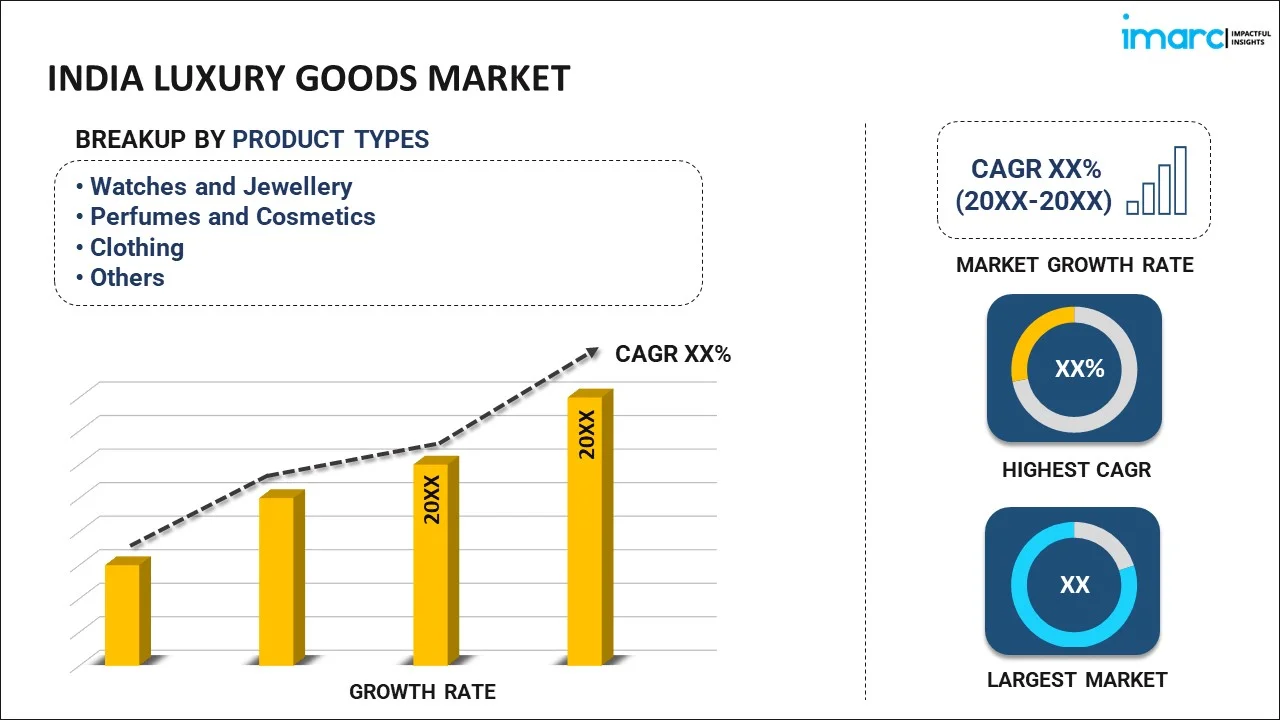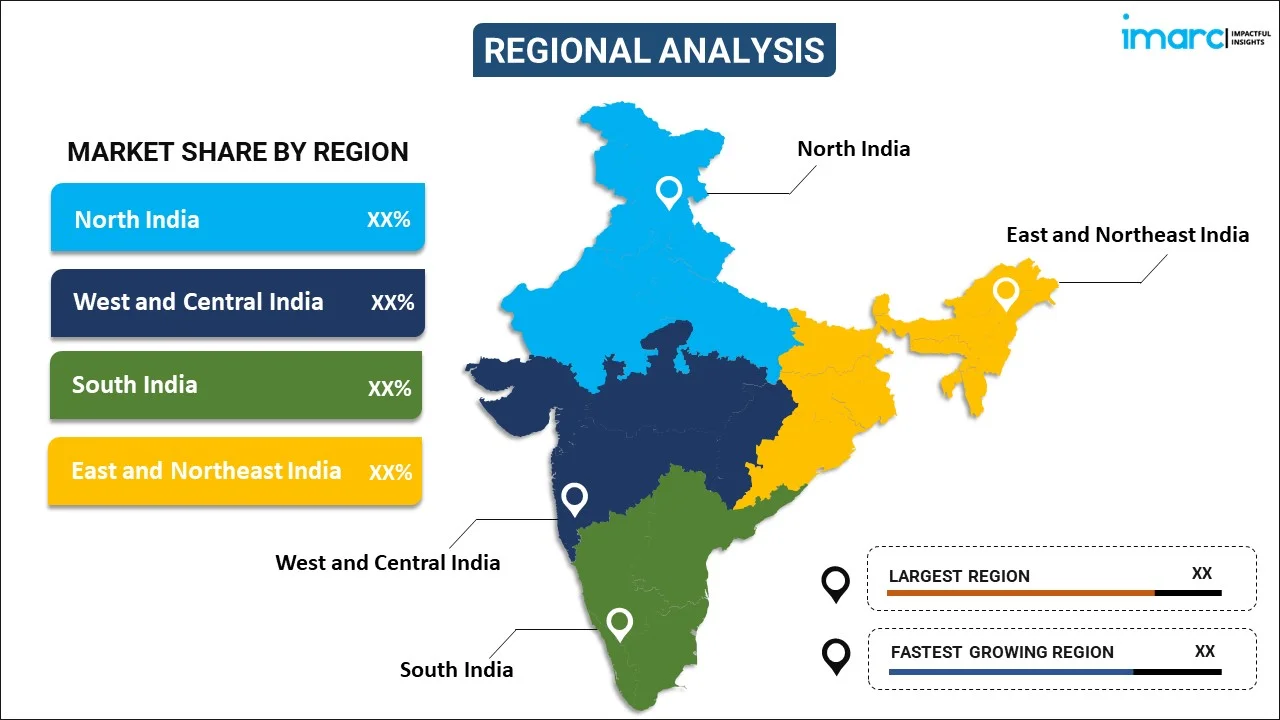
India Luxury Goods Market Report by Product Type (Watches and Jewellery, Perfumes and Cosmetics, Clothing, Bags/Purse, and Others), Distribution Channel (Offline, Online), End User (Women, Men), and Region 2025-2033
Market Overview:
India luxury goods market size reached USD 10.0 Billion in 2024. Looking forward, IMARC Group expects the market to reach USD 17.9 Billion by 2033, exhibiting a growth rate (CAGR) of 6.37% during 2025-2033. The rise of online platforms and social media, which has changed the way consumers discover, research, and purchase luxury goods, is driving the market.
|
Report Attribute
|
Key Statistics
|
|---|---|
|
Base Year
|
2024
|
|
Forecast Years
|
2025-2033
|
|
Historical Years
|
2019-2024
|
|
Market Size in 2024
|
USD 10.0 Billion |
|
Market Forecast in 2033
|
USD 17.9 Billion |
| Market Growth Rate 2025-2033 | 6.37% |
Luxury goods refer to high-quality, often prestigious items that are associated with superior craftsmanship, exclusivity, and a strong brand identity. These products, ranging from fashion and accessories to automobiles and timepieces, often command premium prices due to their exceptional materials, meticulous attention to detail, and limited availability. Luxury is not merely a functional attribute but an aspirational lifestyle choice, symbolizing status and refinement. Consumers of luxury goods seek a unique experience, often valuing the brand's heritage and the emotional connection it fosters. The luxury market is characterized by its resilience to economic fluctuations, as consumers view these items as investments in quality and an expression of personal taste and sophistication. As the demand for exclusivity and prestige continues, luxury goods play a significant role in the economy and cultural landscape.
India Luxury Goods Market Trends:
The luxury goods market in India is propelled by a multitude of factors, each contributing to its sustained growth and resilience. Primarily, the rising regional affluence and increasing disposable incomes have significantly elevated consumer spending on high-end products. Moreover, the growing influence of social media and the desire for status and exclusivity drive consumers to seek luxury items as a means of self-expression. Furthermore, the expanding middle and upper classes in India have become pivotal drivers, fostering a surge in demand for luxury goods. In addition to demographic shifts, evolving consumer preferences and a burgeoning appreciation for craftsmanship and heritage contribute to the market's upward trajectory. As consumers increasingly prioritize experiences over possessions, luxury brands are adapting by offering unique and personalized products and services. Additionally, the digital transformation has enabled brands to reach a wider audience through e-commerce platforms, further fueling market expansion. Environmental and ethical considerations are emerging as influential factors in the luxury goods sector, with a growing demand for sustainable and responsibly sourced products. This shift reflects a broader societal trend towards conscious consumption, impacting consumer choices and reshaping the landscape of the luxury market. In conclusion, a combination of economic, social, and cultural factors converges to drive the dynamics of the luxury goods market, ensuring its continued evolution and adaptability in the regional marketplace.
India Luxury Goods Market Segmentation:
IMARC Group provides an analysis of the key trends in each segment of the market, along with forecasts at the country level for 2025-2033. Our report has categorized the market based on product type, distribution channel, and end user.
Product Type Insights:

- Watches and Jewellery
- Perfumes and Cosmetics
- Clothing
- Bags/Purse
- Others
The report has provided a detailed breakup and analysis of the market based on the product type. This includes watches and jewellery, perfumes and cosmetics, clothing, bags/purse, and others.
Distribution Channel Insights:
- Offline
- Online
A detailed breakup and analysis of the market based on the distribution channel have also been provided in the report. This includes offline and online.
End User Insights:
- Women
- Men
The report has provided a detailed breakup and analysis of the market based on the end user. This includes women and men.
Regional Insights:

- North India
- West and Central India
- South India
- East and Northeast India
The report has also provided a comprehensive analysis of all the major regional markets, which include North India, West and Central India, South India, and East and Northeast India.
Competitive Landscape:
The market research report has also provided a comprehensive analysis of the competitive landscape in the market. Competitive analysis such as market structure, key player positioning, top winning strategies, competitive dashboard, and company evaluation quadrant has been covered in the report. Also, detailed profiles of all major companies have been provided.
India Luxury Goods Market Report Coverage:
| Report Features | Details |
|---|---|
| Base Year of the Analysis | 2024 |
| Historical Period | 2019-2024 |
| Forecast Period | 2025-2033 |
| Units | Billion USD |
| Scope of the Report | Exploration of Historical Trends and Market Outlook, Industry Catalysts and Challenges, Segment-Wise Historical and Future Market Assessment:
|
| Product Types Covered | Watches and Jewellery, Perfumes and Cosmetics, Clothing, Bags/Purse, Others |
| Distribution Channels Covered | Offline, Online |
| End Users Covered | Women, Men |
| Regions Covered | North India, West and Central India, South India, East and Northeast India |
| Customization Scope | 10% Free Customization |
| Post-Sale Analyst Support | 10-12 Weeks |
| Delivery Format | PDF and Excel through Email (We can also provide the editable version of the report in PPT/Word format on special request) |
Key Questions Answered in This Report:
- How has the India luxury goods market performed so far and how will it perform in the coming years?
- What has been the impact of COVID-19 on the India luxury goods market?
- What is the breakup of the India luxury goods market on the basis of product type?
- What is the breakup of the India luxury goods market on the basis of distribution channel?
- What is the breakup of the India luxury goods market on the basis of end user?
- What are the various stages in the value chain of the India luxury goods market?
- What are the key driving factors and challenges in the India luxury goods?
- What is the structure of the India luxury goods market and who are the key players?
- What is the degree of competition in the India luxury goods market?
Key Benefits for Stakeholders:
- IMARC’s industry report offers a comprehensive quantitative analysis of various market segments, historical and current market trends, market forecasts, and dynamics of the India luxury goods market from 2019-2033.
- The research report provides the latest information on the market drivers, challenges, and opportunities in the India luxury goods market.
- Porter's five forces analysis assist stakeholders in assessing the impact of new entrants, competitive rivalry, supplier power, buyer power, and the threat of substitution. It helps stakeholders to analyze the level of competition within the India luxury goods industry and its attractiveness.
- Competitive landscape allows stakeholders to understand their competitive environment and provides an insight into the current positions of key players in the market.
Need more help?
- Speak to our experienced analysts for insights on the current market scenarios.
- Include additional segments and countries to customize the report as per your requirement.
- Gain an unparalleled competitive advantage in your domain by understanding how to utilize the report and positively impacting your operations and revenue.
- For further assistance, please connect with our analysts.
 Inquire Before Buying
Inquire Before Buying
 Speak to an Analyst
Speak to an Analyst
 Request Brochure
Request Brochure
 Request Customization
Request Customization




.webp)




.webp)












